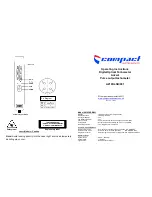
the next available stack location. Therefore, the exit stack starts four words below
the initial stack pointer.
ISP-8 - Status register = 2700
ISP-6 - Program Counter = 0000000a
ISP-2 - Vector Offset = 007C
The monitor is always exited using the FOUR WORD STACK frame, and the
monitor always uses 07C as the vector offset. When running a program from the
monitor after entering from reset, the powerup status word of 2700 is used.
Therefore, the only difference you will see in this stack frame will be because of
different initial program counters.
The procedure for setting the initial stack pointer and initial program counter can be
automated by using the initial vectors configuration question to define these values.
cf rv=<initial ISP>,<target program starting address>
Once this configuration has been set up, the following reset sequence may be useful
on systems that remap memory to provide reset vectors.
rst -m
r
Breaking into the foreground monitor
The next thing to try with the foreground monitor is to see if you can break into it
from your target program. The emulator uses a nonmaskable interrupt (interrupt 7)
to break into the monitor. The interrupt is generated in such a way as to not
interfere with any interrupts pending in your target system. The resulting interrupt
acknowledge cycle is not shown to the target system. The associated stacking is in
foreground memory at the location determined by the interrupt stack pointer. If the
target system program is running in Master mode, there will also be stacking on the
master stack.
A vector fetch occurs sometime during or after stacking. The emulator provides the
data for this vector fetch to correctly run the foreground monitor. While the
emulator is transitioning into the foreground monitor, interrupts are temporarily
blocked. Once in the monitor the interrupt mask level is lowered to the greater of
the "monint" configuration setting or the target program mask level.
Chapter 18: Connecting the Emulator to a Target System
Installing Emulator Features
658
Summary of Contents for 64783A
Page 30: ...xxx ...
Page 31: ...Part 1 Quick Start Guide 1 ...
Page 33: ...1 Getting Started 3 ...
Page 70: ...40 ...
Page 75: ...Part 2 Using The Emulator 45 ...
Page 140: ...110 ...
Page 141: ...4 Using the Emulator How to control the processor and view system resources 111 ...
Page 227: ...5 Using the Emulation Bus Analyzer How to record program execution in real time 197 ...
Page 290: ...260 ...
Page 331: ...8 Configuring the Emulator 301 ...
Page 382: ...352 ...
Page 383: ...9 Solving Problems What to do when the emulator doesn t behave as expected 353 ...
Page 397: ...Part 3 Reference 367 ...
Page 399: ...10 Using Memory Management Understanding logical and physical emulation and analysis 369 ...
Page 429: ...11 Emulator Commands The command syntax reference for the emulator softkey interface 399 ...
Page 443: ...copy Chapter 11 Emulator Commands copy 413 ...
Page 451: ...display Chapter 11 Emulator Commands display 421 ...
Page 457: ...DISPLAY MEMORY Chapter 11 Emulator Commands DISPLAY MEMORY 427 ...
Page 461: ...DISPLAY MMU Chapter 11 Emulator Commands DISPLAY MMU 431 ...
Page 464: ...DISPLAY TRACE Chapter 11 Emulator Commands DISPLAY TRACE 434 ...
Page 480: ...modify Chapter 11 Emulator Commands modify 450 ...
Page 501: ...set Chapter 11 Emulator Commands set 471 ...
Page 514: ... SYMB Chapter 11 Emulator Commands SYMB 484 ...
Page 582: ...552 ...
Page 583: ...13 Setting X Resources 553 ...
Page 598: ...568 ...
Page 606: ...576 ...
Page 613: ...16 Specifications and Characteristics 583 ...
Page 627: ...Part 4 Concept Guide 597 ...
Page 629: ...17 X Resources and the Graphical User Interface 599 ...
Page 639: ...Part 5 Installation and Service Guide 609 ...
Page 697: ...19 Installation and Service 667 ...
Page 746: ...Chapter 19 Installation and Service Verifying the Installation 716 ...
Page 755: ...20 Installing Updating Emulator Firmware 725 ...
Page 762: ...732 ...
Page 778: ...748 ...
Page 810: ...X server 554 604 X Window System 54 Index 780 ...
















































